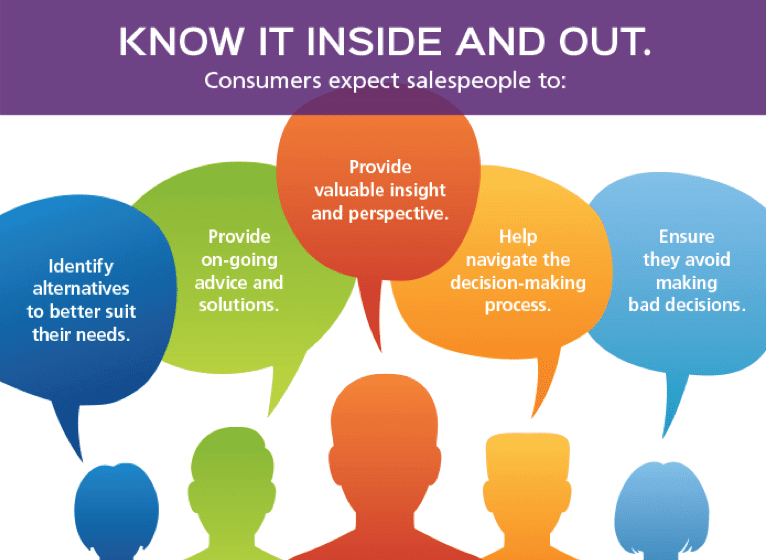Predictive analytics and consultative selling among the most important trends for B2B sales strategy in 2017
As a marketer, you’re more than familiar with the importance of closing the gap between marketing and sales. It’s been proven over and over that the more these teams talk, the better the results.
Yet according to Aberdeen group, salespeople still spend an average of 440 hours a year searching for the right content to use. Furthermore, 65% of marketing content isn’t used by sales at all!
When looking at the most popular sales trends for 2017, three are crucial when bridging this gap. These trends are most likely to inform your sales enablement content over the next year and beyond
In this article, we’re going to analyse each trend to see not only how they will contribute to your sales enablement efforts, but your marketing strategy as a whole.
1. Subject Matter Experts will Play Salesperson & Marketer
The majority of B2B buyers would rather do business with someone they perceive as an expert on a particular matter over a salesperson.
Subject matter experts (SME) will have an important role in the sales process in 2017 and beyond. These executives provide enough value that a prospect would be willing to pay to meet with them. In a sense, this is a new form of consultative selling that takes a more advisory role.
The graphic below from 4imprint presents a good argument for having SMEs present in your organization:

Historically, sales leaders would lead SMEs within their organizations. They were guided through the sales process and called upon when needed. However, some organizations are beginning to empower their SMEs to manage the sales process themselves, providing them with teams and systems as support.
As this shift takes place, marketing must also get involved. Like sales should support the SME with the right people, marketing must assist with the right content.
Give your SMEs access to a library of content that you have already created. This is the easiest and fastest route to getting them involved and assisting them through the sales process. Sit down with your SME and interview them. Ask questions like:
- What are the most common questions asked by prospects?
- What content doesn’t exist that you’d like to see?
- What can we create to make educating your audience easier?
Having these insights not only helps in assisting the SME, but can also inform your own content efforts across every stage of the funnel. Dig deep on each answer to gain valuable insight. Topics that prospects are hungry for provide promising content opportunities.
Recruit your SME to act as a thought leader for your organization. Guest blogging is one effective method of expanding into a wider audience. Provide value for other audiences in order to attract them to you.
Get your SME in front of a camera and create practical and insightful video content. This turns your in-house thought leader into a source of content that can cater to several audiences throughout the entire sales cycle. If you’ve been considering YouTube as a marketing channel but haven’t been sure where to start, then this could act as a cost-effective experiment.
When presenting these ideas, make sure you show what’s in it for them. Convince your SMEs that these opportunities will not only serve their own interests, but will benefit the wider organization.
2. Data-Driven Sales will Inform Marketing
Marketing has known the value of data for a long time. And it looks like sales are finally catching up.
Thanks to sales analytics systems, teams can finally understand how they’re closing deals and measure impact on revenue. Insight on who their buyers are and what the ideal customer looks like allows sales to focus on prospects that matter.
This includes behavioral data as well, yielding insight on how they act and when they buy. Not only does this help sales efficiency, but is a treasure trove of insight for marketing.
By taking this data, marketing can focus on revenue goals as well as their own lead generation targets. The benefits of this insight include:
- Predicting behaviors: by gathering data on past purchase and user behavior, marketing can predict future engagement and sales events. Sales can use this to focus on selling the right products to the right leads, while marketing can take this insight and refine their message-to-market match.
- Sales emails: sales teams can now collect data on the calls-to-action and subject lines that lead to responses. Marketing must take this insight and apply it to their own marketing, uncovering certain triggers that generate a conversion or response further down the funnel.
- Touchpoint attribution: we can now connect the entire journey from the very beginning all the way to the end. This is useful for long sales cycles. Many marketing teams often “hand over” leads to sales, refocusing attention on more lead gen. Instead, marketers can inform sales messaging and vice versa.
Having access to this data will help you create more of the right content, both for sales enablement and other marketing efforts. There is an opportunity to make content more effective and meaningful at all stages of the funnel.
3. Embracing a Multimedia Content Library
Sales enablement content typically comes in the form of blog posts or ebooks. But the way we consume content is changing, and sales enablement must follow suit.
Videos, infographics and interactive content will have important roles in the overall content marketing strategy. So how can you apply this to sales enablement?
The subject matter expert can be a great source of sales enablement, essentially “scaling” their function. Animated explainer videos, recorded demos and webinars can are also key when empowering sales to educate and nurture their prospects.
Infographics make assimilating information easier for prospects. This visual format simplifies complex topics, which is useful when engaging with busy senior executives. Test how infographics affect the sales process with tools such as Venngage and Canva. Infographics are easy to create with their WYSIWYG editors, meaning you can test on a small scale before considering hiring a designer.
Interactive content is also having its time in the limelight. With tools such as Ceros, you can make static eBooks, infographics and websites engaging and visually appealing.
Finally, consider interviewing other thought leaders. This will help add authority, allowing a third party expert to chime in on complex matters.
Turn these interviews into more video content and podcasts to cater to different viewing styles. If someone would rather listen to an interview “on-the-move” they have the option to do so.
Sales may face several industry-shaking changes this year. For marketers, these three trends are going to affect you the most. Getting in on these approaches early means you can serve leads and prospects faster than your competition, assisting sales to turn more leads into customers.

Timo Rein is the co-founder and president of
Pipedrive, a provider of sales CRM software that gives sales teams control over their selling processes. He has 15-plus years experience as a salesman, sales manager and software entrepreneur. Before co-founding Pipedrive, Rein helped build a leading sales and management training house in the Baltics. Prior to that, he was among the top one percent door-to-door salesmen with Southwestern Company.




 Timo Rein is the co-founder and president of
Timo Rein is the co-founder and president of 



